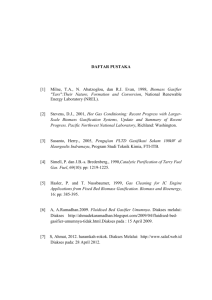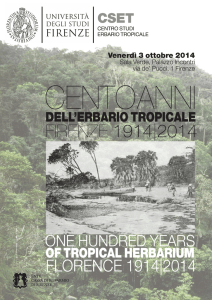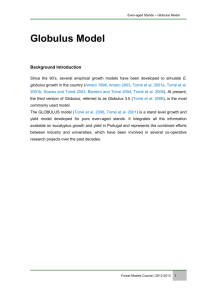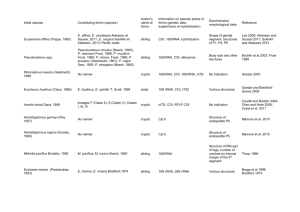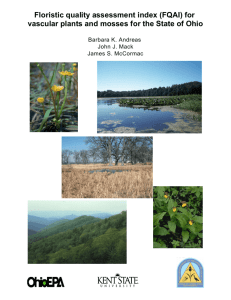gcbb12321-sup-0001
advertisement
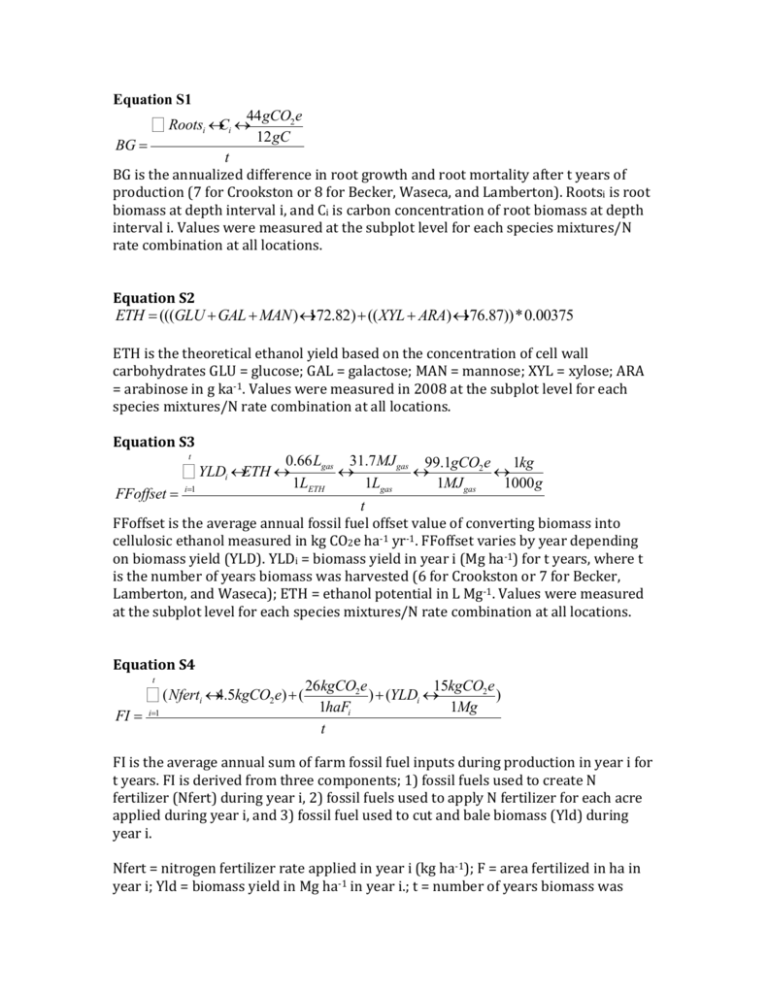
Equation S1 BG = å Roots ´ C ´ i i 44gCO2 e 12gC t BG is the annualized difference in root growth and root mortality after t years of production (7 for Crookston or 8 for Becker, Waseca, and Lamberton). Rootsi is root biomass at depth interval i, and Ci is carbon concentration of root biomass at depth interval i. Values were measured at the subplot level for each species mixtures/N rate combination at all locations. Equation S2 ETH = (((GLU + GAL + MAN)´172.82)+ ((XYL + ARA)´176.87))*0.00375 ETH is the theoretical ethanol yield based on the concentration of cell wall carbohydrates GLU = glucose; GAL = galactose; MAN = mannose; XYL = xylose; ARA = arabinose in g ka-1. Values were measured in 2008 at the subplot level for each species mixtures/N rate combination at all locations. Equation S3 t åYLD ´ ETH ´ i FFoffset = i=1 0.66Lgas 31.7MJ gas 99.1gCO2 e 1kg ´ ´ ´ 1LETH 1Lgas 1MJ gas 1000g t FFoffset is the average annual fossil fuel offset value of converting biomass into cellulosic ethanol measured in kg CO2e ha-1 yr-1. FFoffset varies by year depending on biomass yield (YLD). YLDi = biomass yield in year i (Mg ha-1) for t years, where t is the number of years biomass was harvested (6 for Crookston or 7 for Becker, Lamberton, and Waseca); ETH = ethanol potential in L Mg-1. Values were measured at the subplot level for each species mixtures/N rate combination at all locations. Equation S4 t å(Nfert ´ 4.5kgCO e) + ( i FI = i=1 2 26kgCO2 e 15kgCO2 e ) + (YLDi ´ ) 1haFi 1Mg t FI is the average annual sum of farm fossil fuel inputs during production in year i for t years. FI is derived from three components; 1) fossil fuels used to create N fertilizer (Nfert) during year i, 2) fossil fuels used to apply N fertilizer for each acre applied during year i, and 3) fossil fuel used to cut and bale biomass (Yld) during year i. Nfert = nitrogen fertilizer rate applied in year i (kg ha-1); F = area fertilized in ha in year i; Yld = biomass yield in Mg ha-1 in year i.; t = number of years biomass was harvested from the system. Values were measured at the subplot level for each species mixtures/N rate combination at all locations. Equation S5 t e(-0.5095+(0.0028´Nferti )+(0.1245´TEMPi ))kgN 2O - N 44kgN 2O 298kgCO2 e ´ ´ å 1ha 28kgN 2O - N 1kgN 2O N 2O = i=1 t N2O is the average GHG emissions value of nitrous oxide emissions (measured in kg CO2e ha-1 yr-1). N2O emissions are estimated as a function of N fertilizer rate (Nfert) and the mean temp in January through April (TEMP) during year i for t years at each location, where t equals the number of years in production after the seeding year. Nfert = nitrogen fertilizer rate in kg ha-1; TEMP = mean temp in January through April in degrees C. Equation S6 t åYLD ´ ETH ´ i ECF = i=1 67kgCO2 e 1lETH t ECFi is the average annual fossil fuel emission in CO2e from converting biomass to cellulosic ethanol. YLD = biomass yield in Mg ha-1 during year i for t years; ETH = ethanol potential in L Mg-1; t = number of years biomass was harvested and converted to ethanol. Values were measured at the subplot level for each species mixtures/N rate combination at all locations. Equation S7 NetGHG = (BG + FFoffset)- FI - N2O - ECF Net GHG mitigation potential is average annual sum of the C sinks minus GHG emissions related to the maintenance of perennial bioenergy cropping systems. Table S1. Plant species sown into species mixture treatments. Treatment Switchgrass Grass mix Grass/legume 12-species High-diversity Species sown Common name1 Latin name Functional group A A Switchgrass Panicum virgatum L. Grass A, B, C, D B Big bluestem Andropogon gerardii Vitman Grass A, B, C, D, I, J, K, L A, B, C, D, I, J, K, L, Q, R, S, T C Sorghastrum nutans L. Elymus canadensis L. or Elymus virginicus L. Grass D Indiangrass Canada wild rye or Virginia wild rye A through X E Little bluestem Schizachyrium scoparium Michx. Grass F Slender wheatgrass Elymus trachycaulus Link Grass G Sideoats grama Virginia wild rye or Canada wild rye Bouteloua curtipendula Michx. Elymus virginicus L. or Elymus canadensis L. Grass Astragalus canadensis L. Baptisia australis L. or Desmodium canadense L. Legume J Canada milkvetch Wild blue indigo or showy tick trefoil K Purple prairie clover Dalea purpurea Vent. Legume Legume Q Partridge pea or pale pea Showy tick trefoil or white prairie clover Roundheaded bushclover or American vetch Butterfly milkweed or purple coneflower Amorpha canescens Pursh Lupinus perennis L. or Glycyrrhiza lepidota Pursh Chamaecrista fasciculate Michx. or Lathyrus ochroleucus Hook. Desmodium canadense L. or Dalea candida Michx. Lespedeza capitata Michx. or Vicia Americana Muhl. Asclepias tuberosa L. or Echinacea purpurea L. R Maximillian sunflower Helianthus maximiliani Schrad. Forb S Stiff goldenrod Solidago rigida L. Forb T Yellow coneflower Ratibida pinnata (Vent.) Barnhart Forb U Rough blazing star or northern Liatris aspera Michx. or Galium Forb H I L Lead plant Perennial lupine or American M licorice N O P Grass Grass Legume Legume Legume Legume Legume Forb bedstraw boreale L. V Wild bergamot Forb W Cup plant or black eyed Susan Monarda fistulosa L. Silphium perfoliatum L. or Rudbeckia hirta L. X Golden Alexander Zizia aurea L. Forb Forb First species within cell corresponds to that planted in southern locations (Becker, Lamberton, and Waseca), while second species was an alternative for northern locations (Crookston). 1 Table S2. Average annual biomass yield (g m-2; SE) of 5 perennial grassland bioenergy crops with and without 67 kg N ha-1 at 4 locations in Minnesota from 2007 (Becker, Lamberton, and Waseca) or 2008 (Crookston) to 2013. Becker Crookston Lamberton Waseca Species mixture 0 kg N ha 67 kg N ha 0 kg N ha 67 kg N ha 0 kg N ha 67 kg N ha 0 kg N ha 67 kg N ha Switchgrass 340 (21.1) 467.2 (47.9) 443.8 (50.9) 690.6 (47.4) 866 (38.4) 994.3 (38.6) 653.7 (36.5) 901.5 (47.8) Grass Polyculture 275 (19.9) 474.2 (39) 549.3 (31) 844 (65.2) 900.2 (41.9) 1027 (52.8) 366.5 (23.6) 651.5 (58.5) Grass/Legume 287.5 (20.2) 479.9 (47) 553.8 (54.2) 545.8 (58.7) 637.3 (49.5) 524.1 (30.5) 554.3 (39.6) 707.4 (76.8) 12-species mix 201.6 (16.7) 263 (37.6) 406.4 (35.4) 488.9 (47.2) 567.5 (58.1) 593.9 (48.2) 503.3 (53) 663.1 (76.3) High Diversity 208.3 (18) 315.9 (38.9) 483.7 (53.7) 519.3 (43.1) 540.6 (28.1) 493.1 (33) 444.1 (39.1) 500.6 (47.9) Table S3. Average theoretical ethanol potential (l Mg-1; SE) from biomass of 5 perennial grassland bioenergy crops with and without 67 kg N ha-1 at 4 locations in Minnesota. Value represent 90% carbohydrate conversion efficiency. Becker 67 kg N ha Lamberton 0 kg N ha 67 kg N ha 0 kg N ha 370 (30) 411 (1.4) 403 (5.2) 417 (1.8) NA NA 396 (2.9) 412 (3.3) 408 (2.3) 405 (2.3) 397 (1.8) 376 (4.1) 345 (18.2) 363 (5.8) 350 (6.2) 358 (10.7) 381 (10.8) 325 (13.1) 319 (1.9) 341 (4.5) 373 (5.5) 348 (3.6) 326 (2.6) 339 (11.5) 339 (5.5) 364 (5) 358 (7.7) 338 (5.2) 327 (11.4) Species mixture 0 kg N ha Switchgrass 417 (0.7) 415 (1.9) 402 (6.7) Grass Polyculture 417 (0.9) 414 (2.3) Grass/Legume 419 (0.7) 404 (9.1) 12-species mix 405 (3.2) High Diversity 375 (31.1) NA 392 (6.1) 0 kg N ha Crookston 67 kg N ha Waseca 67 kg N ha Switchgrass Grass mix Grass/legume 12−species High−diversity 0 kg 67 kg (a) (b) Root Carbon (g kg-1) 40 30 20 10 0 0−30 30−60 60−90 0−30 30−60 60−90 Depth (cm) Figure S1. Root carbon content (± 95% CIs) at three depth intervals for five native perennial bioenergy crop mixtures managed with and without 67 kg N ha-1. 0 kg N ha-1 30 67 kg N ha-1 (a) Becker Crookston Lamberton Waseca 20 10 0 0 kg N ha-1 67 kg N ha-1 Root Biomass (Mg ha-1) (b) 4 3 2 1 0 0 kg N ha-1 3 67 kg N ha-1 (c) 2 1 Sw itc hg ra ss G ra ss m ix G ra ss /le gu m 12 e −s pe ci es m H ix ig h− di ve rs ity Sw itc hg ra ss G ra ss m ix G ra ss /le gu m 12 e −s pe ci es m H ix ig h− di ve rs ity 0 Treatment Figure S2. Variation in root biomass (mean ± SE) within treatments and across locations in depth intervals from 0-30 cm (a), 30-60 cm (b), and 60-90 cm (c). The scale of the y-axes were adjusted for each depth interval to better highlight site-level variation within each species mixture treatment. 67 kg 0 kg Switchgrass Grass mix Grass/legume 12−species High−diversity Change in soil TOC (g kg-1) 4 0 −4 −8 0−15 15−30 30−45 0−15 45−60 15−30 30−45 45−60 Depth Figure S3. Change in soil organic carbon (± 95% CIs) at three depth intervals for five native perennial bioenergy crop mixtures managed with and without 67 kg N ha-1.
